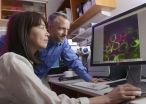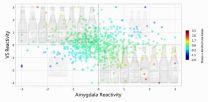Regenerative medicine biologists discover a cellular structure that explains fate of stem cells
2015-07-01
(Press-News.org) DALLAS - July 1, 2015 - UT Southwestern Medical Center scientists collaborating with University of Michigan researchers have found a previously unidentified mechanism that helps explain why stem cells undergo self-renewing divisions but their offspring do not.
Adult stem cells provide a ready supply of new cells needed for tissue homeostasis throughout the life of an organism. Specialized environments called "niches" help to maintain stem cells in an undifferentiated and self-renewing state. Cells that comprise the niche produce signals and growth factors essential for stem cell maintenance. The mechanisms that allow for reception of these signals exclusively by stem cells and not their more specialized progeny remain poorly understood.
"This finding stands to change the way we think about how stem cells and their neighbors communicate with one another," said Dr. Michael Buszczak, Associate Professor in the Department of Molecular Biology and with the Hamon Center for Regenerative Science and Medicine.
The findings are presented in the journal Nature.
Scientists have been working to understand how the signaling between niches and stem cells works.
"These signals act over a short range, so only stem cells ? but not their differentiating progeny ? receive the self-renewing signals," said Dr. Buszczak, E.E. and Greer Garson Fogelson Scholar in Medical Research. "The mechanics of this communication were not known. What we discovered was that the stem cells form microtubule-based nanotubes, which extend into the niche. These threadlike nanotubes act like straws to tap into the niche and allow signaling to occur specifically in the stem cell."
The findings emanate from an active collaboration between the Buszczak lab at UT Southwestern and the lab of Dr. Yukiko Yamashita at the University of Michigan. Dr. Yamashita is an Associate Professor of Cell and Developmental Biology at the University of Michigan Life Sciences Institute and a Howard Hughes Medical Institute (HHMI) Investigator.
First author Dr. Mayu Inaba, a Postdoctoral Research Fellow at the Life Sciences Institute and a visiting Senior Fellow in Molecular Biology at UT Southwestern in the Buszczak lab, noticed thin projections linking individual stem cells back to a central hub in the stem cell "niche." Dr. Yamashita looked through her old image files and identified the same connections in numerous images. "I had seen them, but I wasn't seeing them," Dr. Yamashita said. Dr. Inaba worked to further develop the project as a senior research fellow in the Buszczak lab over the last several years.
The findings are important groundwork for understanding how stem cells reproduce and how miscommunication between cells can result in diseases like cancer. Too much stem cell production, for example, can lead to cancerous growth. Too little reproduction can result in inadequate renewal of cells and underlies the aging process.
The long-term goal of Dr. Buszczak's lab is to determine the complete regulatory network that controls both the maintenance of Drosophila stem cells and the differentiation of their daughters. "We hope to use this information as a foundation for understanding how perturbations in normal gene expression programs cause disease," Dr. Buszczak said.
INFORMATION:
The mission of the Hamon Center for Regenerative Science and Medicine is to impact human health through discoveries of the fundamental mechanisms of tissue formation and repair, and to use this knowledge to develop transformative strategies and medicines to enhance tissue regeneration. The Center is led by Dr. Eric Olson, Chair of Molecular Biology at UT Southwestern.
The research was supported by the HHMI and the MacArthur Foundation.
About UT Southwestern Medical Center
UT Southwestern, one of the premier academic medical centers in the nation, integrates pioneering biomedical research with exceptional clinical care and education. The institution's faculty includes many distinguished members, including six who have been awarded Nobel Prizes since 1985. The faculty of more than 2,700 is responsible for groundbreaking medical advances and is committed to translating science-driven research quickly to new clinical treatments. UT Southwestern physicians provide medical care in 40 specialties to about 92,000 hospitalized patients and oversee approximately 2.1 million outpatient visits a year.
This news release is available on our home page at
http://www.utsouthwestern.edu/
To automatically receive news releases from UT Southwestern via email,
subscribe at http://www.utsouthwestern.edu/receivenews
[Attachments] See images for this press release:

ELSE PRESS RELEASES FROM THIS DATE:
2015-07-01
DURHAM, N.C. - A pair of brain-imaging studies suggest researchers may be able to predict how likely young adults are to develop problem drinking or engage in risky sexual behavior in response to stress.
The new research is part of the ongoing Duke Neurogenetics Study (DNS), which began in 2010 to better understand how interactions between the brain, genome and environment shape risky behaviors that can predict mental illnesses including depression, anxiety, and addiction.
"By knowing the biology that predicts risk, we hope to eventually change the biology -- or at ...
2015-07-01
GeoSpace
Beijing quadrupled in size in a decade, new study finds
Researchers tracked the changing physical infrastructure in Beijing, China, and found that the city's physical area quadrupled between 2000 and 2009, according to a new study published in Journal of Geophysical Research: Atmospheres.
Eos.org
Seismic Hazard Assessment: Honing the Debate, Testing the Models
Earthquake experts learn that "take a hike" isn't an insult, but a way to resolve hotly debated scientific issues. The scientists found common ground by trekking over it.
New research papers
Disappearance ...
2015-07-01
For decades, researchers in the genetics field have theorized that the protein spools around which DNA is wound, histones, remain constant in the brain, never changing after development in the womb. Now, researchers from the Icahn School of Medicine at Mount Sinai have discovered that histones are steadily replaced in brain cells throughout life - a process which helps to switch genes on and off. This histone replacement, known as turnover, enables our genetic machinery to adapt to our environment by prompting gene expression, the conversion of genes into the proteins that ...
2015-07-01
Washington, D.C., July 1, 2015--The vast majority of consumers recognize that multivitamins, calcium and/or vitamin D supplements can help fill nutrient gaps but should not be viewed as replacements for a healthy diet, according to a new survey conducted on behalf of the Council for Responsible Nutrition (CRN). Conclusions from the survey of more than 2,000 U.S. adults were published in Nutrition Journal in a peer-reviewed article titled, "Consumer attitudes about the role of multivitamins and other dietary supplements: report of a survey," authored by CRN consultant Annette ...
2015-07-01
Neurons in a brain region called the medial temporal lobe play a key role in our ability to quickly form memories about real-life events and experiences, according to a study published July 1st in Neuron. By recording from individual neurons in patients, the researchers reveal for the first time in humans the single-cell basis for the creation of episodic memories.
"It was impressive to see how individual neurons signalled the learning of new contextual associations between people and places and that the changes in firing could occur just after one instance," says lead ...
2015-07-01
The brain region that helps people tell whether an object is near or far may also guide how emotionally close they feel to others and how they rank them socially, according to a study conducted at the Icahn School of Medicine at Mount Sinai and published today in the journal Neuron. The findings promise to yield new insights into the social deficits that accompany psychiatric disorders like schizophrenia and depression.
The study focused on evidence for the existence of a "social map" in the hippocampus, the part of the brain that remembers locations in physical space ...
2015-07-01
If your eyes deceive you, blame your brain. Many optical illusions work because what we see clashes with what we expect to see.
That 3D movie? Give credit to filmmakers who exploit binocular vision, or the way the brain merges the slightly different images from the two eyes to create depth.
These are examples of the brain making sense of the information coming from the eyes in order to produce what we "see." The brain combines signals that reach your retina with the models your brain has learned to predict what to expect when you move through the world. Your brain solves ...
2015-07-01
Neurons are a limited commodity; each of us goes through life with essentially the same set we had at birth. But these cells, whose electrical signals drive our thoughts, perceptions, and actions, are anything but static. They change and adapt in response to experience throughout our lifetimes, a process better known as learning.
Research conducted at The Rockefeller University and collaborating institutions has uncovered a new mechanism that makes this plasticity possible. This discovery centers on a specific type of histone, proteins that support DNA and help control ...
2015-07-01
WASHINGTON (July 1, 2015) -- Researchers at the George Washington University (GW), led by Michael S. Irwig, M.D., found that men referred for tertiary care for borderline testosterone levels had much higher rates of depression and depressive symptoms than those of the general population.
"In an era where more and more men are being tested for "Low T" -- or lower levels of testosterone -- there is very little data about the men who have borderline low testosterone levels," said Irwig, associate professor of medicine and director of the Center for Andrology at the GW School ...
2015-07-01
A University of Texas at Arlington materials science and engineering team has developed a new energy cell that can store large-scale solar energy even when it's dark.
The innovation is an advancement over the most common solar energy systems that rely on using sunlight immediately as a power source. Those systems are hindered by not being able to use that solar energy at night or when cloudy conditions exist.
The UT Arlington team developed an all-vanadium photo-electrochemical flow cell that allows for efficient and large-scale solar energy storage even at nighttime. ...
LAST 30 PRESS RELEASES:
[Press-News.org] Regenerative medicine biologists discover a cellular structure that explains fate of stem cells



